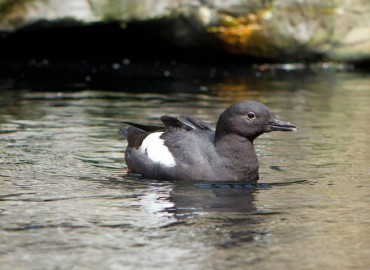
There is at least one bird that really whistles. Most of the time, when you hear what sounds like a whistling bird, it is air passing through its feathers when it flies.
This “whistler” is a small, black bird seen on Northwest waters all year. The pigeon guillemot’s vocal endeavor has been described as a “feeble, wheezy, or hissing whistle.” I think it has a pretty good whistle — when you consider it doesn’t have lips or teeth to blow through.
Whistling guillemots are easy to hear when you are near their nesting territory. They whistle continually while flying back and forth from the water to the nest with food for their young.
Most young guillemots are raised in burrows built into high, sandy cliffs. Where you find these cliffs along the water, look for guillemots.
Some of these birds are now nesting within the dock structures at several ferryboat locations. Look under the docks at the Kingston-Edmonds ferry to see them. The fishing pier is the best location for peering beneath the dock.
Guillemots are black during the spring and summer. They will soon be exchanging this plumage for one of black and white. In all plumages, they have bright-red feet. These are easy to see when they dive under the water in their “bottoms up” style.
This bird is one of the auks and a member of the Alcidae family. This group of birds is considered a northern counterpart of penguins. They have one major difference. Auks can fly.
They aren’t the greatest flyers in the bird world. Their wings are small in relation to their bodies. But they do fly and penguins don’t.
When guillemots fly by, you will see their small wings beating furiously, working to keep them airborn. When they land on the water, they plunge straight in — as if they have run out of fuel and must make a crash landing.
They use their wings to fly under the water too. This makes them excellent underwater swimmers. That’s important when you are after fish.
Their name refers to the small, pigeon-like head that sits on a rather long neck. Other auks, like the murrelets and auklets, have short necks. They look like blocks of wood floating on the water.
Guillemots, especially in the summer, have a dapper look about them. Only when they open their mouths or dive under the water, do they appear just a little comical.
They not only flash bright-red feet as they give a little hop and dive, the insides of their mouths are also red. This is easiest to see when they are whistling.
So how does a guillemot whistle?
That’s a good question. Most of the technical books skate around the answer. Apparently the birds just open their mouth and whistle.
Some say they hiss. Try hissing with your mouth open. It’s about as easy as whistling while you yawn.
Pigeon guillemots communicate with their mouths wide open. Flashing their bright-red gapes at each other is part of their socializing. These gregarious little birds will gather in groups to sport about, whistle at one another and have a good time in each other’s company.
They can appear friendly toward humans. This is hard to explain, but when watching guillemots on the water, they seem friendly. Perhaps this is due to the fact that they tolerate human presence better than other water birds. You can stand beneath a cliff where they are busy feeding their young and they won’t fly into a tizzy at the sight of you.
These northern “penguin-like” birds are seen alone, in pairs or in small groups. They are common on our inland waters. They’re easy to see right now because most of the water birds haven’t returned yet.
This is a good time to look for a small, black bird with two white wing patches and a pigeon-like head. You just might hear or see it whistle.

























